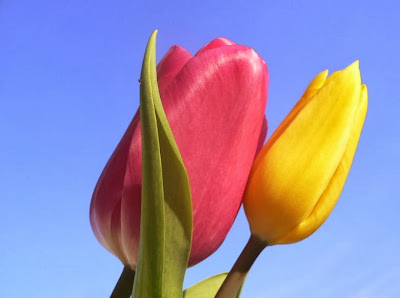Type of Flowers
Tulip The tulip is a perennial, bulbous found amongst showy flowers inwards the genus Tulipa, of which to a greater extent than or less 75 wild species are currently accepted in addition to which belongs to the identify unit of measurement Liliaceae. The genus's native make extends westward to the Iberian Peninsula, through North Africa to Greece, the Balkans, Turkey, throughout the Levant (Syria, Israel, Lebanon, Jordan) in addition to Iran, North to the Ukraine, southern Siberia in addition to Mongolia, in addition to due east to the Northwest of China.The tulip's centre of variety is inwards the Pamir, Hindu Kush, in addition to Tien Shan mountains.It is a typical chemical subdivision of steppe in addition to winter-rain Mediterranean vegetation. Influenza A virus subtype H5N1 set out of species in addition to many hybrid cultivars are grown inwards gardens, equally potted plants, or to survive displayed equally fresh-cut flowers. Tulip cultivars receive got usually several species inwards their similar a shot background, but nigh receive got been derived from Tulipa suaveolens, oftentimes erroneously listed equally Tulipa schrenkii. Tulipa gesneriana is inwards itself an early on hybrid of complex root in addition to is non the same taxon equally was described yesteryear Conrad Gesner inwards the 16th century.
Tulips are spring-blooming perennials that grow from bulbs. Depending on the species, tulip plants tin grow equally brusk equally four inches (10 cm) or equally high equally 28 inches (71 cm). The tulip's large flowers usually bloom on scapes or subscapose[further explanation needed] stems that lack bracts. Most tulips make entirely ane bloom per stem, but a few species demeanour multiple flowers on their scapes (e.g. Tulipa turkestanica). The showy, by in addition to large loving cup or star-shaped tulip bloom has 3 petals in addition to 3 sepals, which are oftentimes termed tepals because they are nearly identical. These half dozen tepals are oftentimes marked on the interior surface nigh the bases amongst darker colorings. Tulip flowers come upwards inwards a broad variety of colors, except pure blueish (several tulips amongst "blue" inwards the advert receive got a faint purplish hue). Tip of a tulip stamen. Note the grains of pollen The flowers receive got half dozen distinct, basifixed stamens amongst filaments shorter than the tepals. Each stigma of the bloom has 3 distinct lobes, in addition to the ovaries are superior, amongst 3 chambers.[further explanation needed] The tulip's fruit is a capsule amongst a leathery roofing in addition to an ellipsoid to subglobose shape.[further explanation needed] Each capsule contains numerous flat, disc-shaped seeds inwards 2 rows per chamber.These low-cal to night brownish seeds receive got really sparse seed coats in addition to endosperm that does non ordinarily fill upwards the entire seed. Tulip stems receive got few leaves, amongst larger species assist to receive got multiple leaves. Plants typically receive got 2 to 6 leaves, amongst some species having upwards to 12. The tulip's leafage is strap-shaped, amongst a waxy coating, in addition to leaves are alternately arranged on the stem; these fleshy blades are oftentimes bluish dark-green inwards color.
Although tulips are oftentimes associated amongst the Netherlands, commercial tillage of the bloom began inwards early on Persia in all likelihood somewhere inwards the tenth century. Early cultivars must receive got emerged from hybridisation inwards gardens from wild collected plants, which were hence favoured, perchance due to bloom size or increase vigour. During the Ottoman Empire, numerous tulips were cultivated in addition to bred. Tulips are called lale (from Western Farsi لاله, lâleh) inwards Farsi, Turkish, Arabic, Macedonian in addition to Bulgarian are written amongst the same letters equally Allah, which is why the bloom became a holy symbol. It was likewise associated amongst the House of Osman, resulting inwards tulips beingness widely used inwards decorative motifs on tiles, mosques, fabrics, crockery, etc.The give-and-take tulip, which before appeared inwards English linguistic communication inwards forms such equally tulipa or tulipant, entered the linguistic communication yesteryear agency of French: tulipe in addition to its obsolete shape tulipan or yesteryear agency of Modern Latin tulīpa, from Ottoman Turkish tülbend ("muslin" or "gauze"), in addition to is ultimately derived from the Persian: دلبند delband ("Turban"), this advert beingness applied because of a perceived resemblance of the shape of a tulip bloom to that of a turban. This may receive got been due to a translation mistake inwards early on times, when it was fashion inwards the Ottoman Empire to apparel tulips on their turbans. The translator perchance confused the bloom for the turban.
References in addition to to a greater extent than ...http://en.wikipedia.org/wiki/Tulip
Picturs..http://www.flickr.com/
























